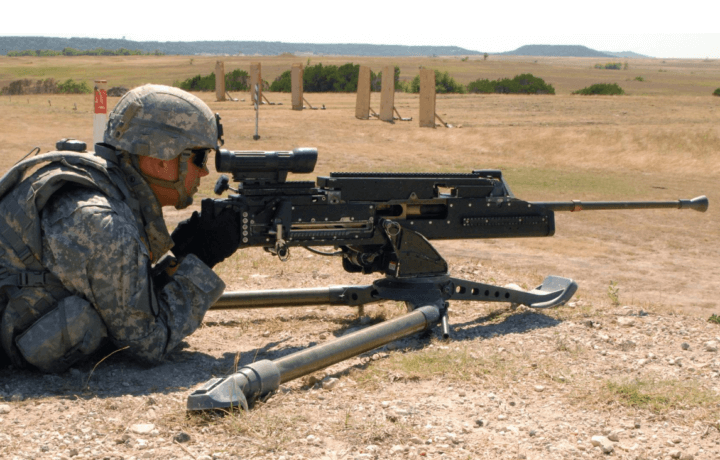While the press has focused on the U.S. Navy’s $12.8 billion USS Gerald R. Ford aircraft carrier and the Pentagon’s $1.5 trillion plus F-35 Joint Strike Fighter, not every DoD military weapon modernization effort is quite at those spending levels. The U.S. Army focuses on technology with new efforts to keep soldiers better connected while in the field and to provide warfighters with the absolute best in situational awareness tools, devices, and even software apps.
Smuzzle Sound and Recoil
Engineers at the U.S. Army’s CCDC Army Research Laboratory, an element of the U.S. Army Combat Capabilities Development Command with the Army Futures Command, have developed a combination suppressor and muzzle brake that has the potential to keep machine guns on target and quieter on the battlefield.
This is the “smuzzle,” a muzzle brake that reportedly could reduce machine gun noise, flash, and recoil all at the same time. The device, which has been in development since 2007 when the Army began to consider the requirements for its next generation infantry weapon, could cut the volume in half at the shooter’s ear while reducing recoil by as much as one third, and even dropping the volume down range by one quarter. Developers used the concept of muzzle brakes for the 155m howitzer and downsized the technology accordingly.
“Jumping between calibers is nothing,” Daniel Cler, an engineer with the Army’s Armaments Center at the Combat Capabilities Development Center. ”We do it all the time. A lot of times we develop large caliber muzzle devices. The principles are pretty much identical.”
Drone On
This month, officials at the Army Contracting Command at Redstone Arsenal, AL, also announced a $425.9 million five-year contract award to Syracuse Research Corp. (SRC). SRC is based in North Syracuse, NY and have been tasked to build and deploy a ruggedized counter-drone system designed to destroy or disable enemy unmanned aerial vehicles (UAVs).
The company will develop, produce, deploy, and support the Expeditionary-Low, Slow, Small Unmanned Aircraft System Integrated Defeat System (E-LIDS), which will shield U.S. and allied expeditionary forces from UAV-based improvised explosive devices (IEDs) and from more sophisticated enemy UAVs.
The contract to develop the E-LIDS comes with a week after another vehicle-mount counter-UAV system was issued to Leonardo DRS Land Systems of St. Louis. That contractor won a $189.8 million five-year contract to develop and build the Mobile-Low, Slow, Small Unmanned Aircraft System Integrated Defeat System (M-LIDS), which will be used to detect, destroy, or disable small, inexpensive UAVs that could include commercial quadcopters that operate as airborne IEDs.
The Better Connected and Networked Soldier
The Army’s combat capabilities development team is currently engaged in its third annual Network Modernization Experiment (NetModX) at Joint Base McGuire-Dix-Lakehurst in NJ. The event will run from July 20 to October 2. It will be an opportunity for the Combat Capabilities Development Command’s C5ISR Center (Command, Control, Communication, Computers, Cyber, Intelligence, Surveillance and Reconnaissance Center) to perform field tests with emerging technologies and capabilities that have previously only been tested in lab conditions.
The theme for this year’s NetModX is mission command and command-post survivability. It will focus on technologies that could be fielded in the Army’s Integrated Tactical Network Capability Set 2023 and Capability Set 2025. These include future iterations of similar network tools that the Army plans to deliver to soldiers in two year cycles. The tests will enable the designers to determine how the technologies react in real world conditions and deal with trees and other terrain issues.
We have an extensive understanding of our near peer adversaries’ abilities to disrupt our communications,” said Dr. Michael Brownfield, the C5ISR Center’s Future Capabilities chief. “We can replicate those electronic attack capabilities against vendor-developed technologies and iteratively mitigate their vulnerabilities as a team.”
Another RFP for Bradley Replacement
One piece of military hardware that deserves a more high-tech take is the delayed optionally manned fighting vehicle (OMFV). The OMFV was re-launched earlier in July as the latest effort to develop a replacement for the Cold War era Bradley Infantry Fighting Vehicle.
Just two weeks ago the Army issued a draft request for proposals for the preliminary design phase of the OMFV, and that was the first step towards the plans to award up to five design contracts next June.
“As we continue to progress through the first phase of our five-phased approach for the OMFV program, communication, inclusive feedback and innovative thinking from industry remains key,” Maj. Gen. Brian Cummings, the Army’s program executive officer for ground combat systems, said in a statement. “We are looking forward to receiving feedback and learning from industry what’s in the realm of the possible as we continue to develop this truly transformational vehicle for our Soldiers.”
ClearanceJobs previously reported that the latest attempt to replace the Bradley with the OMFV was nixed back in February. That marked the third time that efforts to replace the aging Bradley were canceled.
The Army had ended the last attempt when only one bidder remained in the competition. As a result, the Army announced that it would launch the effort again to ensure more competition. OMFV is now the first large acquisition effort to come out of the Army Futures Command.




